“I still remember standing at the door of the old school down town Leeds and seeing the Hindenberg fly right over my head. That must have been fall 1931 or spring 1932. I wonder how much aerial photography they did on that trip.” Edric Clarke ’31-’38
“I cannot remember the year this incident happened - perhaps early 1941. We girls were out on the South Drive of school - perhaps break time or lunch time. We became aware of a fighter plane flying very low over the playing fields from the West Park end of the playing fields - therefore nose on to us so we were unable to see any identification marks as to whether it was ‘one of ours’ or not. Panic Stations!!! I seem to remember Miss Wallace was the mistress in charge at the time. She screamed at us to do whatever!! - and we pupils scattered in all directions. Then the plane whizzed over the school with what seemed like inches to spare and made off in the direction of the small housing estate where I lived with my parents. When I arrived home later in the day, my Mother plus neighbour were very upset about a plane which had just skimmed the roof tops etc. Fortunately it was ‘one of ours’. Someone reported the incident and it transpired the pilot was the son of the people who lived opposite to us. He had just gained his wings and was showing off to his Mother and frightening everybody else to pieces! Needless to say he was grounded for a time - I suspect not for long - as pilots and planes were in very short supply.” Audrey Toothill ’37-’42
“I started in the Kindergarten in '43, I can't remember too much except that I hid under the sand table on the first day. 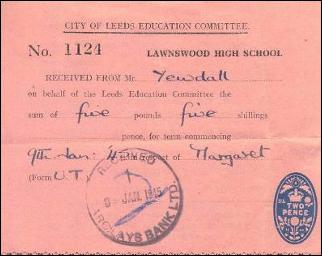 We had (or we were supposed to have) a sleep in the afternoon on canvas beds.” Irene Furze ’43-’54
We had (or we were supposed to have) a sleep in the afternoon on canvas beds.” Irene Furze ’43-’54
“I found the enclosed receipt. Prior to the 1944 Education Act, schooling had to be paid for and this has survived 60 years! Amazingly, it is dated January 1945 - maybe it didn’t come into effect until after that.” Margaret Yewdall ’44-’54
“During and immediately after the war the windows were covered with a sticky mesh-like covering to avoid the glass splintering if the building was bombed. I seem to remember people who sat by the windows used to try to peel this off in idle moments.” Irene Furze ’43-’54
“I remember when we all cheered the king and queen and the two princesses with our red, white and blue scarves as they drove past the school.” Sheila Fingret ’41-’47
“We all sat on the hall floor to hear King George V1th open the Festival of Britain in 1951.” Catherine MacDonald ’49-’54
“I remember my parents couldn’t afford to let me go to the Festival of Britain (London 1951) on a week’s school trip. The cost was two weeks wages for my Dad, who worked on the railway. It was £10, a fortune in those days! I did go to Malham & the Yorkshire Dales, fossil hunting though! Never to be forgotten simple pleasures!” Avril Escolme ’46-’51
“As the 70th anniversary of the Queen's accession approaches, those of us who took our scholarship on the 6th February 1952 will probably remember that day. I was about ten and a half years old, and I can't remember how I travelled to Lawnswood from my home which was about a 10 minute walk from the Town Hall! I remember getting off a tram and my lisle stockings slipping down (worn because of a knee problem). On our way home, myself and another girl from our school, Burley Road, missed our stop at North Lane, went on to St. Michael's and eventually took another tram and went to Hyde Park, from where we walked back to our homes, (quite a walk). On the way a boy told us that the King had died. As soon as I reached home, that was the first thing my mother told me. Nowadays I can't imagine we would be making such a journey on our own.” Joan Tetley ’52-’57
“I remember my first visit to Lawnswood, which was to sit for the Scholarship - as the 11+ used to be called. We were all shepherded in the East wing playground, before being led in to a ground floor classroom for the exam. I was petrified as my two older sisters had both passed it and I was terrified that I might not. About five minutes before the end I realized that I’d added up all the "take-away" sums, and had to hastily scribble the correct answers (I hoped!) over the top. Then came the agonising wait of two or three months for the result!” Heather Newman ’53-’60
“I had two marvellous friends - Eileen Suthers and Anne Johnson. There was also Sheila Solly, Sheila Dalton, Midge Midgley, Brenda Wrigglesworth. On my first day at the school we sat in 1B at individual desks with lift-up lids and in alphabetical order. When our teacher had addressed us we each had to stand up and give our name. I remember poor Brenda blushing scarlet when she had to give hers.” Hilary Steeple ’44-’51
“I remember Founders’ Day. [24th July] We always sang one particular Hymn (‘Our Father, by whose Servants’).” Janet Ball ’56-’61
“I remember the Road Safety classes and tests.” Barbara Catton ’57-’62
“When I started at LHS in ’53 the trams were still running to Lawnswood. The rule was that boys must travel upstairs and girls down. I suppose it never dawned on the staff that since passengers were not allowed to stand on the upper deck, it was the girls who did all the standing up for adults. The tram driver changed ends and as there were steps at both ends the rule was the boys should get on at the front and girls at the back so never the twain should meet. (Ridiculous when only six weeks before those of us from Queen’s Road Junior had been sitting at double desks with the boys).” Pat Thompson (Tommy) ’53-’60
“I can remember going to school on the old Samuel Ledgard buses. When you look back it was quite a challenge for an 11 year old to get on a bus and know to get off at the right stop. Even worse was waiting for the buses during the winter months - especially at Xmas time when they were usually full of Xmas shoppers. In my first and second year during the summer I was allowed to go to school on my bike - providing I went Farrar Lane, along The Drive, and down Spen Lane on forward journey - so as to avoid the roundabout on a morning. My parents would have had a fit if they had seen us going down Spen Lane at top speed!!” Margaret Eastwood ’59-’66
“When I was there, there were little garden plots near the Spen Lane end - they must have been a legacy of Digging For Victory. You could have one for a year at a time, and use it to grow veg and flowers.” Val Hill ’56-’61
“I think I tried to grow flowers, but I don't know which ones. I have a vague memory that Miss Gill used to wander by now and again to offer advice, but in reality there wasn't any guidance or help available. Gardening was recreation, not education! The gardening tools — hoes, forks, etc., — were kept in a tea chest just inside the North Drive door. We just helped ourselves and returned them when we’d finished.” Sandra Baker ’59-’64
“We had small allotments between a rhododendron hedge and the back of the tennis/netball courts and I distinctly remember frying the lettuce we had grown, together with raisins and dripping in a flat tin over a small fire lit in the hedge with Eileen [Suthers] and Anne [Johnson] and declaring it “delicious” at the time.” Hilary Steeple ’44-’51
“In the sixth form we went to the annexe and had our own coffee machine, and watched Wimbledon.” Pat Curtis ’59-’65
“Also remember Ernie and his mate who looked after the boilers? Used to ogle us when we ran out for games. I wonder if they were the boiler men for the Modern as well or if they had their own?” Janet Ball ’56-’61
“I remember Miss Holden giving a very moving talk on the life and death of Kathleen Ferrier the opera singer; she had very obviously been an admirer if not a friend.” Catherine MacDonald ’49-’54
“One day we had Gladys Aylward & her adopted Chinese daughter Sixpence. She talked of life from Lancashire? to being a missionary in China and the horrors of the war with the Japanese. When the Inn of the Sixth Happiness was in the cinema it was interesting to compare info.” Catherine MacDonald ’49-’54
“Does anyone remember Gladys Aylward, the Missionary from China, (whose life was filmed as "The Inn of the Sixth Happiness"), coming to talk to the school about her life and experiences?” Brenda Nichols ’55-’62
[From the dates above, it seems Miss Aylward visited the school at least twice...]
“Does anyone remember how each class chose a charity to support every year? I chose LGI for our Year 5 in 1967. Cake sales at break time were the usual thing.” Jennifer Pearson née Peace ’63-’68
“I remember the changing rooms on the South Drive being used as Polling Stations during General Elections. During the time they were in use we weren’t allowed onto the South Drive, nor were we allowed down the stairs that ran from the corridor to the gym.” Sandra Baker ’59-’64
“The changing rooms were used as a polling station in the early ’50s but I don’t think we were banned from the South Drive. I seem to remember watching people going in to vote.” Irene Furze ’43-’54
“I can remember the whole school walking down to the Cottage Road cinema to see a film of the Coronation [1953].” Irene Furze ’43-’54
“I still have a very battered Coronation mug given by the Education Committee for the Queen’s Coronation. Actually it’s a half-pint glass beer mug with the coat-of-arms on.” Catherine MacDonald ’49-’54
“Mrs Pickering (History) was very instrumental in investigating the history of Lawnswood School at the 100th Anniversary of the girls' school. I am pretty sure she was the writer of the pamphlet about the school that was published at that time.” Margaret Bradbrook ’59-’66
“In 1972 we won the Alice Croft award for overcoming significant difficulties and still succeeding. Jane because her parents had divorced and Elisabeth because she was the eldest of 6 kids and from a poor family — my how times have changed. We were given £24 each which we used to buy towels and lab coats for college - it was very welcome!” Jane Porter & Elisabeth McGough ’65-’72
“I remember the red and green counters for first and second dinners and that one class still had to take sandwiches to eat in the classroom. The crab apple trees along the South Drive. The embarrassing, noisy machines which gobbled your sanitary towels and were installed, in full view of the corridor, near the sinks.” Jennifer Pearson née Peace ’63-’68

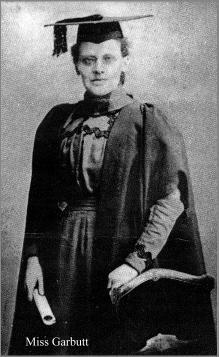 London University, she was the first graduate to take charge of the school and refused the title of Head Governess. One of the 'houses' into which the school was later organised bore her name. (The others were Roscoe, Graham and Stowell.) Her rather stiff portrait looks intimidating but she seems to have been both well respected and well liked. One old girl wrote of happy recollections of her time at the school, including Christmas parties when Miss Garbutt would lead off the dancing with Herr Radstock, the dancing master.
London University, she was the first graduate to take charge of the school and refused the title of Head Governess. One of the 'houses' into which the school was later organised bore her name. (The others were Roscoe, Graham and Stowell.) Her rather stiff portrait looks intimidating but she seems to have been both well respected and well liked. One old girl wrote of happy recollections of her time at the school, including Christmas parties when Miss Garbutt would lead off the dancing with Herr Radstock, the dancing master.
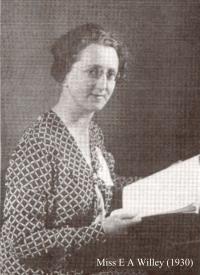 'So Hateth She Derknesse', by G.E.Evans in Leeds Reference Library and I have plundered the section on her time at Lawnswood for some of these notes.
'So Hateth She Derknesse', by G.E.Evans in Leeds Reference Library and I have plundered the section on her time at Lawnswood for some of these notes.
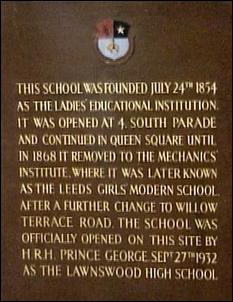 Weetwood on the outskirts of Leeds, when once again the name of the school changed, this time to Lawnswood High School. A plaque marked the occasion.
Weetwood on the outskirts of Leeds, when once again the name of the school changed, this time to Lawnswood High School. A plaque marked the occasion. 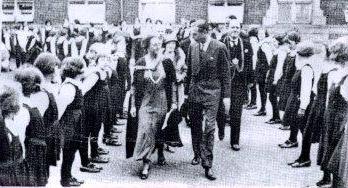 Harewood House where he was staying with his sister, the Princess Royal. Although somewhat taken aback when he tapped on her door, Miss Willey rose to the occasion and accompanied him, relaxed and smiling, on his tour. She later recalled that he 'had a stiff neck and seemed to need mothering'.
Harewood House where he was staying with his sister, the Princess Royal. Although somewhat taken aback when he tapped on her door, Miss Willey rose to the occasion and accompanied him, relaxed and smiling, on his tour. She later recalled that he 'had a stiff neck and seemed to need mothering'.
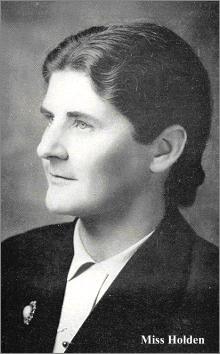
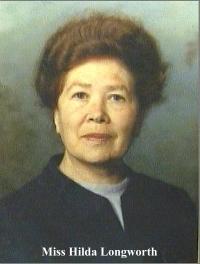 Miss Holden retired in 1960 and was replaced by Miss H. Longworth.
Miss Holden retired in 1960 and was replaced by Miss H. Longworth.  We had (or we were supposed to have) a sleep in the afternoon on canvas beds.” Irene Furze ’43-’54
We had (or we were supposed to have) a sleep in the afternoon on canvas beds.” Irene Furze ’43-’54